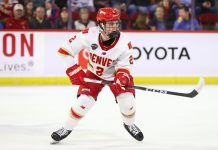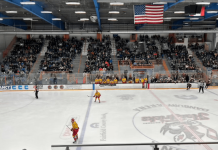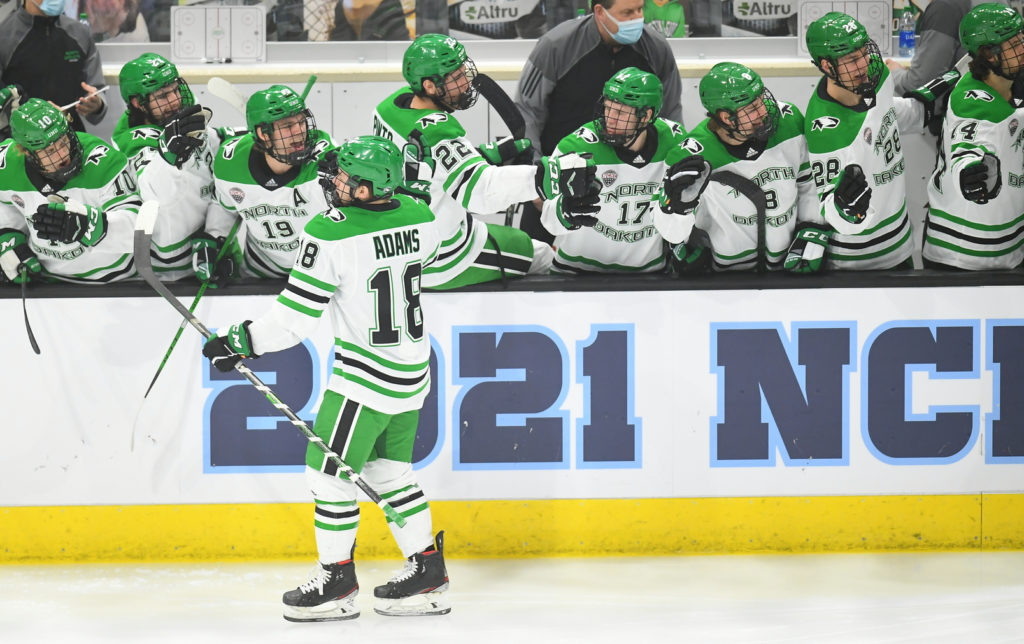
Fargo Regional, March 26-27
Scheels Arena, Fargo, N.D.
Friday, March 26, 4 p.m. Eastern time, ESPNU/WatchESPN
No. 2 Minnesota Duluth (14-10-2) vs. No. 3 Michigan (15-10-1)
Friday, March 26, 9:30 p.m. Eastern time, ESPN3/WatchESPN
No. 1 North Dakota (21-5-1) vs. No. 4 American Int’l (15-3-0)
Saturday, March 27, 7:30 p.m. Eastern time, ESPNU/WatchESPN
Fargo Regional Championship
AMERICAN INTERNATIONAL
Season record: 15-3-0 (11-1-0, 1st in Atlantic Hockey)
Playoffs to this point: Won Atlantic Hockey tournament (beat Niagara in semifinals, beat Canisius in title game)
Top players: senior defenseman Brennan Kapcheck (0-18-18), senior forward Tobias Fladeby (9-8-17), senior forward Justin Cole (9-7-16), senior forward Chris Dodero (7-11-18), junior forward Chris Theodore (4-14-18)
Top goalie: senior Stefano Durante (9-3, 2.17 GAA, .907 SV%)
Why they will advance to Pittsburgh: Why not? In 2019, AIC stunned top-seeded St. Cloud in the first round. Since 2015, Atlantic Hockey teams have won four of their five opening games, including three victories over the overall No. 1 seed. The Yellow Jackets enter the tournament with the best winning percentage in the field at .833 (15-3-0) and the longest winning streak (seven games).
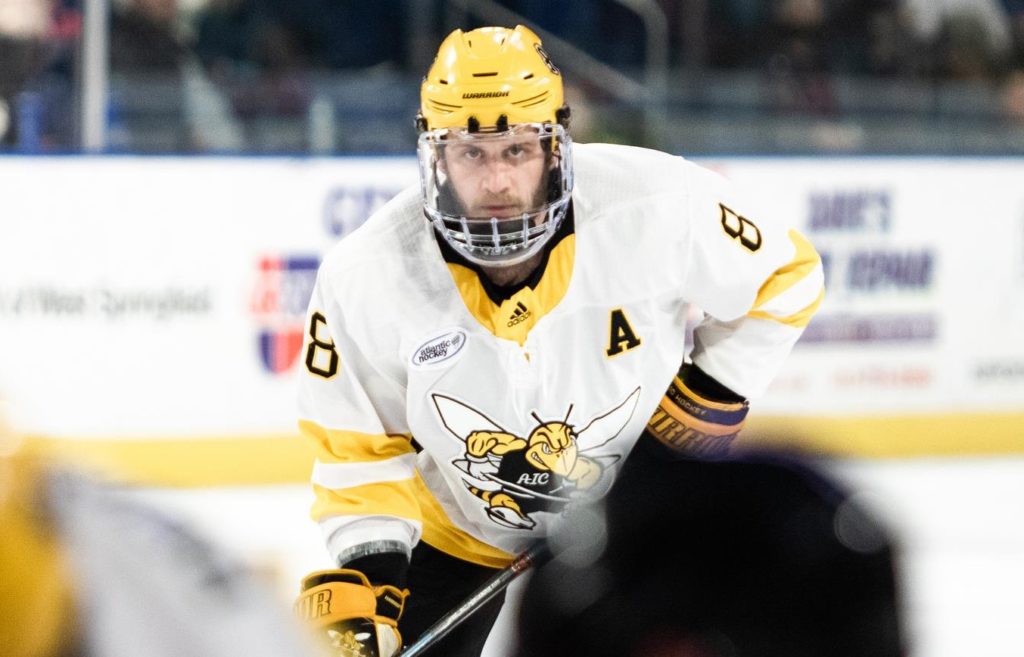
Why they will not advance to Pittsburgh: As the No. 16 seed, AIC has the toughest road to the Frozen Four, starting off with top-seeded North Dakota. The Fargo regional looks especially challenging, with Michigan and two-time defending national champion Minnesota Duluth also in the mix.
American International enters the NCAA tournament the way it did in 2019, and the way all but one Atlantic Hockey team has since the league’s inception in 2003 – on a winning streak. With the exception of Niagara in 2013, it’s been only the winner of the conference tournament that has made the NCAA tournament.
That’s fine with AIC coach Eric Lang, whose Yellow Jackets face off against top-seeded North Dakota.
“I think there’s something to playing your way in,” said Lang. “To do that, you have to show resilience. You’re going to be battled tested for this tournament, because here, you’re one and out.”
The Yellow Jackets showed plenty of resilience in the Atlantic Hockey tournament. Prior to its semifinal game against Niagara, AIC had gone a stretch of 49 days without playing due to various COVID protocols, which included Bentley having to bow out of a quarterfinal series against Lang’s team on short notice.
AIC had to come from behind to win against Niagara in the semis, and again against Canisius in the championship game.
“I was worried (about the layoff) but not really worried,” said Lang. “We had great practices, intense practices. And the layoff gave us a chance to watch a lot of video on ourselves and learn a lot about ourselves.”
In 2019, AIC upset top-seeded St. Cloud in Fargo, 2-1, thanks to a 33-save performance by Zackarias Skog. Eight current Yellow Jackets saw action in that game, while current starting goaltender Stefano Durante watched from the bench.
AIC will need a stellar performance from Durante against the Fighting Hawks.
“He’s always prepared,” said Lang. “He’s not physically imposing but he’s a winner. He’s won every place he’s been. He’s got a confidence about him that gives our whole group confidence.”
AIC will need that against an imposing Fight Hawks team playing close to home.
“I ruined my Sunday watching (video of) them”, said Lang. “North Dakota is a great, great team.”
It might have been different for AIC had St. Lawrence not had to pull out of the tournament. The Yellow Jackets would probably have been the No. 15 seed, and headed to nearby Albany to face off against Boston College.
But instead, it’s North Dakota in Fargo.
“We’re going to go wherever they tell us to go and put our best foot forward,” said Lang. “People on that committee work hard and do a deeper dive than we have and I respect that. There are no easy games this time of the year.”
One advantage – the Yellow Jackets will be able to play in front of some fans at Scheels Arena, most likely around 1,500 based on current occupancy rules.
“That will matter to our players and I think they deserve it,” said Lang. “There won’t be a lot of people screaming for AIC, but they’ll get to hear applause, boos, everything. It’s really exciting.”
— Chris Lerch
MICHIGAN
Season record: (15-10-1, 11-9-0-0 Big Ten, third)
Playoffs to this point: Beat Ohio State B1G quarterfinal, lost in overtime to Minnesota in the Big Ten semifinal
Top players: Forwards Thomas Bordeleau (8-22—30), Kent Johnson (9-18—27), Matty Beniers (10-14—24), Brendan Brisson (10-11—21); defensemen Cam York (4-16—20), Owen Power (3-13—16)
Top goalie: Strauss Mann (11-9-1, 1.89 GAA, .930 SV%)
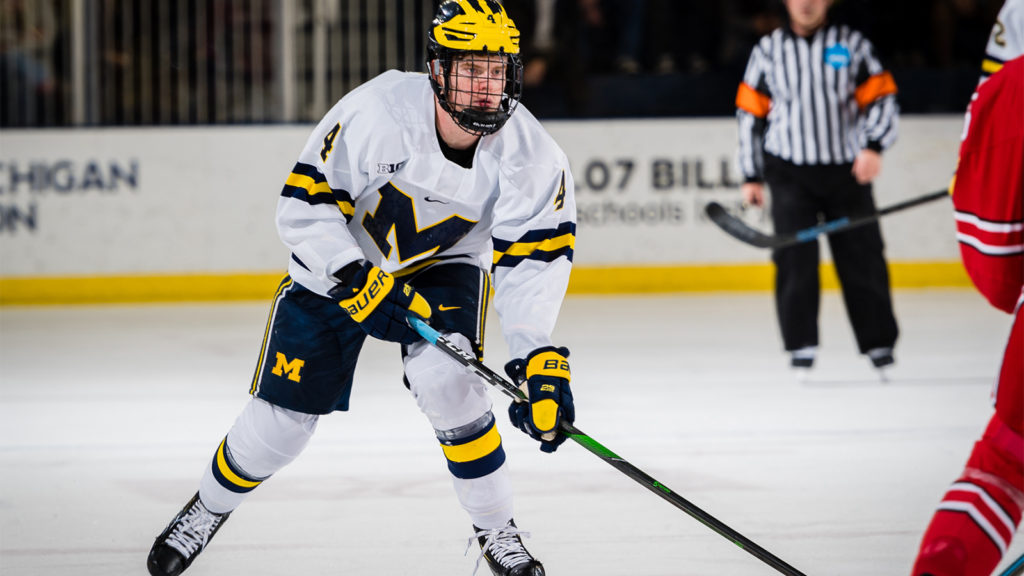
Why they will advance to Pittsburgh: The Wolverines are loaded with talent and are deep in every position. They play disciplined hockey and they’re fast. With their youth and relative inexperience compared to everyone else in their bracket, no one expects them to advance. They have nothing to lose or to prove – and they’re good enough to go.
Why they will not advance to Pittsburgh: Their youth is a double-edge sword. While they have experienced players with Frozen Four experience, Michigan is led in scoring by a freshman class that’s never played anyone but Big Ten opponents.
“Oh, wow.” That was Michigan coach Mel Pearson’s reaction to where the Wolverines landed in the NCAA tournament.
“You’ve got two teams that won both their regular season and their playoff championships in North Dakota and AIC,” said Pearson, “and then you’ve got the two-time defending national champions in Duluth.”
While it’s a bit daunting on paper, said Pearson, the Wolverines are the proverbial we’re-just-happy-to-be-here team, and not only because it’s NCAA tournament time.
“We’re just really thankful and happy to be in the tournament because you never know how it’s going to turn out,” said Pearson. The Wolverines were forced to pause from Jan. 23 until the end of the first week in February along with the entire Michigan athletic department because of a local surge in in the British COVID-19 variant known as B.1.1.7. Even though no one in the hockey program tested positive, everyone was in isolation.
“I thought our young men handled it great,” said Pearson. “There was no practice. There was no facility use. They couldn’t go to another building.
“We weren’t the same team when we came back from that and we realized that not only as a staff, but I think our team did. It took us a good two to three weeks.” The Wolverines were 5-1 through January before that pause. Since returning to play, Michigan has gone 5-4-1. “You just can’t take 14 days there and almost 23 days between games,” said Pearson. “It’s hard to take that much time off.”
Much has been made of Michigan’s youth this season, and rightly so. The Wolverines’ top four offensive threats are freshman forwards and a sophomore and rookie defenseman round out Michigan’s top half dozen scorers. This is a team, though, that’s led in other ways by a senior class that went to the Frozen Four in 2018.
And those talented rookies “have been around,” said Pearson.
“They know what it takes to win, they’ve done a lot of winning there, so we have to play our game,” said Pearson. “I think that’s biggest thing. We have to put pressure on them, we have to use our speed, we have to play well defensively like we have all year. Everybody talks about our offense and our skill and our young guys but you know what? We play pretty good defense, too.”
How good? How about top in the Big Ten and fourth-best in the nation? Michigan scores 3.50 goals per game but allows just 1.96. This team may be young in many ways, but it’s disciplined around the puck.
And that youth, said Pearson, can be a real advantage.
“I’ve been in maybe 26 NCAA tournaments,” said Pearson. “I’ve had a lot of experience. I’ve seen teams that are really good but they’re so uptight. You build the game up to something and you just don’t play. Then I’ve been around teams that are young and loose and they don’t know any better. They just go play. Sometimes it’s okay to have those young guys.”
— Paula C. Weston
MINNESOTA DULUTH
Season record: 14-10-2 (3rd in NCHC)
Playoffs to this point: Lost in NCHC semifinal to St. Cloud State, 3-2
Top players: Senior forward Nick Swaney (13-14-27), junior forward Jackson Cates (10-16-26), senior forward Kobe Roth (13-10-23), junior forward Cole Koepke (13-8-21)
Top goalie: Ryan Fanti (10-7-2, 2.39 GAA, .905 SV%)
Why they will make it to Pittsburgh: Minnesota Duluth has played in the last three national championship games, winning the last two. Coach Scott Sandelin knows how to get the most out of his players in the postseason.
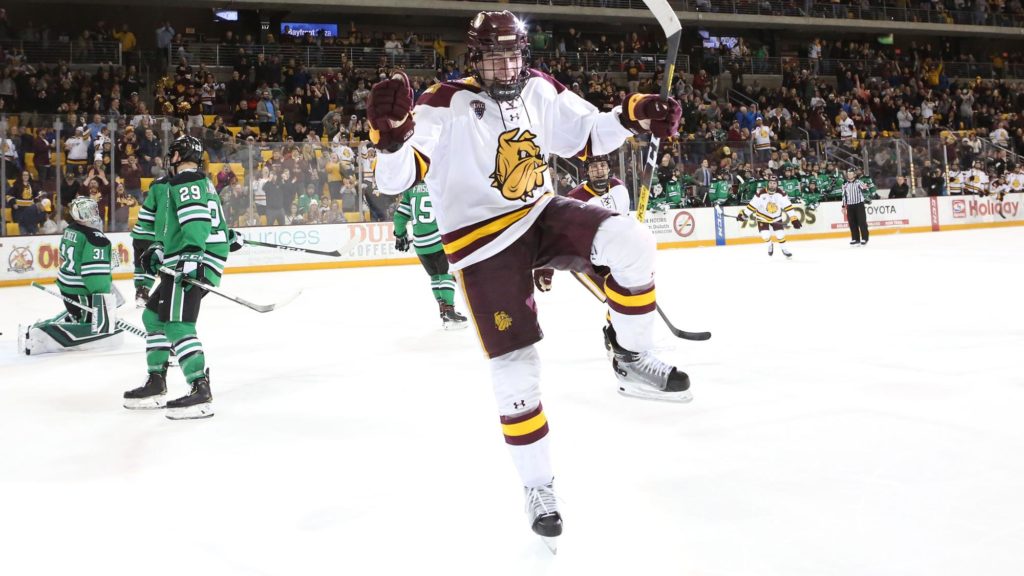
Why they won’t make it to Pittsburgh: The Bulldogs stumbled down the stretch and have only won two of their last seven. Further, the players who were the backbone of the stingy defense that got the Bulldogs their last two championships, defenseman Scott Perunovich and goalie Hunter Shepard, are gone.
Minnesota Duluth has been one of the most consistent teams in the NCAA tournament over the last decade. The Bulldogs have a current national best six straight NCAA tournament appearances, and since the beginning of the regional format, the Bulldogs are a perfect 10-0 in first-round tournament games. Coach Scott Sandelin’s .786 winning percentage in the NCAA tournament is the best among active NCAA coaches.
UMD will play Michigan in the first round; assuming their perfect record continues, they will likely have to go through North Dakota in the quarterfinals, a tall task. They can at least be thankful it’s not St. Cloud, whom they went 2-5 against this season. This is the first time the Bulldogs have played Michigan since defeating them in overtime in the 2011 NCAA championship game in St. Paul.
The Bulldogs are the two-time defending NCAA champions for a reason: Sandelin knows how to get the best out of his team in the playoffs. Before COVID-19, the Bulldogs were one of the favorites to make the NCAA title game again last season. UMD has won three national championships in the last decade and played in four title games.
While the Bulldogs have been strong this season offensively, notching the fourth-highest goal total with 90, their defense has at times let them down, and it’s one reason they stumbled down the stretch, losing five of their last seven.
However, both of UMD’s NCHC tournament games were classic playoff games, one-goal affairs decided by a timely bounce. In the quarters, the Bulldogs got the bounce in OT, while in the semis, a wraparound by Chase Brand eluded Ryan Fanti and gave St. Cloud a win, ending the Bulldogs’ 13-game postseason win streak.
“We lost a one-goal game; the streak’s come to an end, got to start a new one,” said Sandelin after the loss,
Fanti has played well this season in the shadow of the two Hunters, Shepard and Miska, who took the Bulldogs to the last three NCAA championship games. The Bulldogs clearly miss defenseman Scott Perunovich, who departed for the pros after his junior season.
“We have two goalies who can play well; you might see a different one if we play again,” said Sandelin after the St. Cloud game. “We have confidence in both of them.”
Offensively, the Bulldogs look like they have in most of the last decade; no super producers, but a lot of players who can put the puck in the net. Cole Koepke was huge for UMD in the game against Western Michigan, while Nick Swaney has been a leader both on the ice and in the locker room.
— Candace Horgan
NORTH DAKOTA
Season record: 21-5-1 (first in NCHC)
Playoffs to this point: Defeated Miami, Denver and St. Cloud State to win NCHC championship
Top players: Defenseman Matt Kiersted (3-18-21), forwards Jordan Kawaguchi (9-25-34), Collin Adams (11-20-31) and Shane Pinto (15-15-30)
Top goalie: Adam Scheel (19-3-1, 1.81 GAA, .928 save percentage)
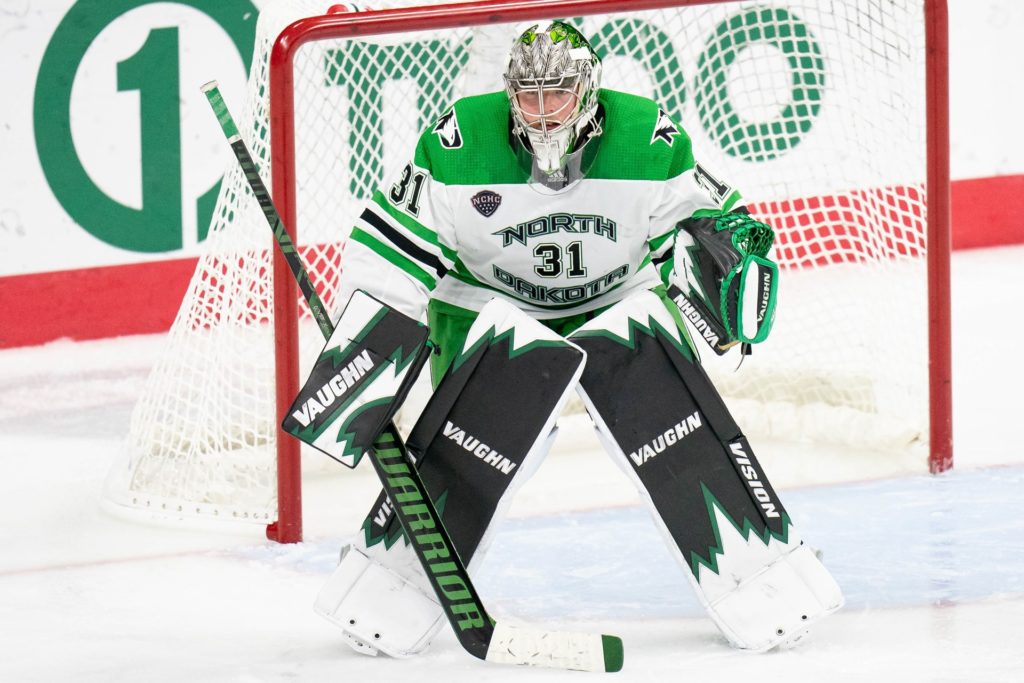
Why they will advance to Pittsburgh: You probably wouldn’t find a single North Dakota fan, player or coaching staff member who thinks the Fighting Hawks wouldn’t have made the Frozen Four last season if the NCAA tournament had gone ahead. UND was 26-5-4 and looked not only set to end a two-year NCAA tourney hiatus, but also make serious waves. Nearly all of UND’s biggest weapons from last season are back, and they’ve been firing.
Why they will not advance to Pittsburgh: UND has been so consistent in its results this season, that Hawks fans could be tempted to see this as a UND-versus-the-field scenario. It isn’t. American International will be more than happy to play the No. 16 role in Fargo — ask St. Cloud State — and playing an hour down the road at Scheels Arena doesn’t guarantee UND anything, either. In 2017, UND crashed out of the NCAA tournament there in the first round, falling in double overtime against Boston University.
Outsiders had high expectations for North Dakota entering this season, and the Fighting Hawks have been as good as advertised.
Is this the season that UND, which was great last season too in a pandemic-shortened campaign, wins its ninth national title? It’s possible, but Hawks coach Brad Berry doesn’t want to hear about that. He and his team are too busy living in the moment, at the business end of a second consecutive season that has been affected by COVID-19.
“I think we were all kind of holding our breath this year, going through the regular season and the NCHC postseason playoffs and just kind of not knowing what the future looks like,” Berry said Tuesday during his weekly press conference. “Now, we’re another day closer to Friday as far as certainty of playing in the NCAA regional here, and our guys are truly excited about that after last year.”
Berry then put the spotlight on his seven-man senior class, headlined by a Hobey Baker Award finalist in Shane Pinto but highly talented across the board.
“This is one of only two teams that have ever came through their freshman year through their senior year and played all four years here with 100 percent returning players in that field, and they’re truly excited about it. We’re playing for our team this year, but we’re also playing for the seniors that didn’t get a chance at playing in the postseason last year.”
UND received a plum draw insofar as the Hawks are the overall No. 1 seed playing very close to home, but this is a tough regional draw. First of all, No. 1 losing to No. 16 is very much a thing in the recent history of this tournament. Furthermore, Minnesota Duluth won the last two national championships, in case anyone has forgotten, and we know better than to underestimate Michigan in the postseason.
That said, Berry feels his battle-tested team is ready for the challenges that will come in Fargo.
“Somebody asked me the other day about, ‘Well, now it’s on to the NCAA regionals and you guys haven’t played in it in a while.’ I don’t think it really matters,” Berry said. “To me, when you go through the NCHC regular-season gauntlet, it’s playoff-type mentality every game on a Friday and Saturday night, and then you go to the NCHC playoff pod in Grand Forks where you play three games and it’s single-elimination, do-or-die situation, that’s (like the) NCAA regionals right there.
“It’s game on, and our guys have played that through the whole year here.”
— Matthew Semisch
